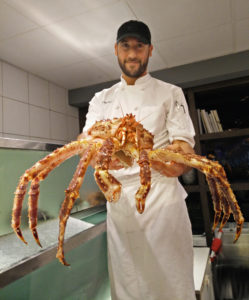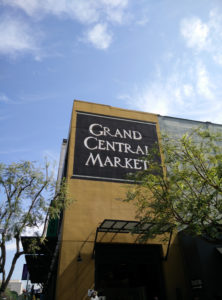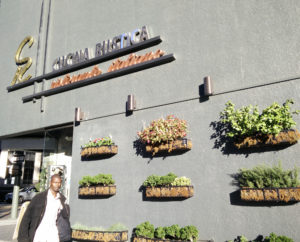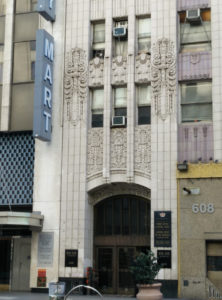Text and Photographs by Mary L. Peachin
Vol. 20, No. 12
Peering into the past, ornate buildings remodeled and converted are noticeable by a thoughtful glance at signage, architecture, and design dating to the late 1800s and early 1900s. Moving time forward, Los Angeles’ financial and historic district has become one hip, hopping destination.
 Centuries old Grand Central Market is thriving in the 1897 Homer Laughlin Building which overflows into the 1905 Laughlin Annex/Lyon Building. During Los Angeles’ heyday, well heeled Bunker Hill residents, who lived in domed, spired Victorian homes, shopped for meat, fresh produce, and dry goods. It was the era of cable cars and open air black Model T Fords chugging along narrow gas lit streets. Following decades of neglect, in 1990, Grand Central Market underwent a major renovation to restore its original signage, retouch murals, and enhance lighting.
Centuries old Grand Central Market is thriving in the 1897 Homer Laughlin Building which overflows into the 1905 Laughlin Annex/Lyon Building. During Los Angeles’ heyday, well heeled Bunker Hill residents, who lived in domed, spired Victorian homes, shopped for meat, fresh produce, and dry goods. It was the era of cable cars and open air black Model T Fords chugging along narrow gas lit streets. Following decades of neglect, in 1990, Grand Central Market underwent a major renovation to restore its original signage, retouch murals, and enhance lighting.
Two economic booms, the discovery of gold and oil attracted residents to what is currently Los Angeles’ downtown area. For almost seventy years, those well-heeled Bunker Hill residents traveled in Sinai and Olivet, two cars operated by the Los Angeles Incline Railway. This mode of cable car transportation, a 1901 funicular known as “Angels Flight,” was financed by Colonel J.W. Eddy. Metal engine-powered cables transported the cars two blocks between its two red boarding stations located on a steep incline at its upper Olive Street terminus and the west corner of Hill Street at Third. The downhill journey was left to gravity, its speed was controlled by the ascending car. An archway labeled “Angels Flight” welcomed passengers at the Hill Street entrance near the Market. When the Funding Company of California purchased the railway from its founders, “Angels Flight” would become the official name of the railway.
In 1897, Homer Laughlin, formerly owner of America’s largest china producer retired from his Pennsylvania pottery plant to Los Angeles. Among his business interests was the development of the California Building, re-named the Homer Laughlin, built at Third and Broadway. Several years later, in 1905, he built the Laughlin Annex/Lyon Building, which would later become the US Postal Service Terminal Annex.
 Grand Central Market, although it suffered from years of decline, has remained in continuous operation since Broadway became the principal commercial and entertainment corridor of downtown Los Angeles.
Grand Central Market, although it suffered from years of decline, has remained in continuous operation since Broadway became the principal commercial and entertainment corridor of downtown Los Angeles.
Downtown’s changing population has been noticeable in Grand Central Market. During the 1920s, almost one hundred vendors included green grocers, fishmongers, Jewish delis, butchers, as well as dry goods, baked goods, flowers, coffee, cheese, and notions. One vendor, who sold only fresh eggs, has, in recent years, become one of the most popular eating concessions. Dozens of hungry folks wait in the order line across market aisles.
In 1984, a downtown developer named Ira Yellin, son of an orthodox rabbi, and a Harvard Law School graduate who would later join the Marine Corps, had an academic interest in urban planning and historical preservation. He bought Grand Central Market, and its adjacent properties including the Million Dollar Theater, operated by Sid Grauman in 1918 as Los Angeles’ first grand movie theater, and landmark Bradbury Building across the street. Commissioned by gold-mining millionaire, Lewis Bradbury, the building would later be named to Los Angeles’ National Register of Historic Places in 1971. The Los Angeles Cultural Heritage Commission would also designate the building as a National Historic Landmark in 1977. In 1990, after decades of neglect, Los Angeles’ Grand Central Market underwent its major renovation. Ira died in 2002, but his widow Adele continues to promote his vision of a dynamic city requiring a vibrant downtown.
By the 1930s, Los Angeles had doubled in size and Skid Row harbored as many as 10,000 homeless people, alcoholics, and other societal drop outs. The area became congregated with saloons, residential hotels, and social services to serve its residents. Almost two decades later Chief of Police Clemence B. Horrall arrested and blocked more than 350 residents. His Assistant Chief, Joseph Reed, claimed that “at least 50 percent of all the Skid Row crime in Los Angeles was impacted. Long time residents were skeptical that the changes would last.
 They should have believed it. While no city is without the homeless or crime free, Los Angeles is clean, busy, and includes multiple districts including Financial, Jewelry, Fashion, not to mention great eateries and things to do.
They should have believed it. While no city is without the homeless or crime free, Los Angeles is clean, busy, and includes multiple districts including Financial, Jewelry, Fashion, not to mention great eateries and things to do.
In the 1970s, Macy’s Plaza was hailed as Los Angeles’ indoor shopping mall, one that filled an entire downtown block. It also boasted a hotel and high-rise office building. For years, tourists flocked to its premier address. These days, the retail store is a dated, downscale relic, one located at the busy intersection of Seventh and Flower Street. Los Angeles developer Wayne Ratkovich is constructing a dramatic Macy’s makeover called The Bloc. This 2.4 million-square-foot property is undergoing a $160-million renovation which will remove the mall’s glass atrium roof, rip out ground-level brick walls, and add additional retail stores and restaurants to adjacent sidewalks. There will be a sunken, sunlit public plaza, a direct connection to a planned subway station, and significant upgrades to the adjacent 23-story, 485-room Sheraton hotel.
Two blocks to the west on Figueroa Street, the former Wilshire Grand Hotel is going to being razed to make way for a $1-billion hotel and office skyscraper, one that will be the tallest building in the West. Three other nearby hotels are under construction, and nearly 1,000 apartments are being built within two blocks of the mall. Several other hotel and residential projects are in planning stages downtown.
The 1912 Brockman Building, a twelve story Classical and Romanesque Revival building commissioned by Brockman between 1841 and1925, was designed by architect George D. Barnett. Brockman’s move started a westward movement of the downtown commercial district and turned Seventh Street and Grand into the city’s high-end retail district. Until 2012, the building was owned by Bank of America who sold to Brooks Brothers. Since 2009, a portion of the building has served as luxury condo then apartment rentals while the corner is occupied by The Bottega Louie restaurant.
 Palatial-Italian, the no reservations white-marble restaurant is hip and noisy. The high ceiling hall-type restaurant is known for its brunch, which includes smoked salmon Benedict served on a crispy potato pancake, New Orleans-type sugared beignets, a brick oven pizza, and Portobello fries. Its simple tables are adorned with ordinary Himalayan pink salt shakers.
Palatial-Italian, the no reservations white-marble restaurant is hip and noisy. The high ceiling hall-type restaurant is known for its brunch, which includes smoked salmon Benedict served on a crispy potato pancake, New Orleans-type sugared beignets, a brick oven pizza, and Portobello fries. Its simple tables are adorned with ordinary Himalayan pink salt shakers.
The Original Pantry, which opened in 1924 in a sketchy Figueroa neighborhood survived the difficult years of the Depression by doling out huge servings of delicious breakfast only entrees. Eight decades later, The Original Pantry remains open 24 hours every day of the year. Originally a single room at 9th and Figueroa St with five employees and a fifteen stool counter, grill and a hot plate, it wasn’t long before patrons were waiting in lines. To offset the wait they were asked to place advance orders. Currently, waiting is part of the watching scene. The Pantry’s current owner, former Los Angeles Mayor Richard Riordan boasts, “We never close. We’re never without a customer.”
Two private clubs offering rooms serve the area. While they have stringent dress codes and smoking policies, they are available by reciprocity memberships or member sponsorship.
The Jonathan Club, 120 years old, originally opened on downtown South Spring Street. Historically, it’s surmised that it was built as a political club for President William McKinley. In 1905, The Jonathan Club moved to what was described as elegant quarters on the top two floors of Pacific Electric Company. Its current thirteen stories Town Club, built on South Figueroa opened in 1925. A second clubhouse, for beach lovers, opened in Santa Monica in 1930.
 Having briefly touched on the hip and the hop, there is more. The 1926 Los Angeles Library garden was built by Bertram Grosvenor Goodhue using a combination Byzantine, Egyptian, modern, and Spanish themed architecture. Most of the terra-cotta bas-reliefs were done by Lee Oskar Lawrie. Jud Fine designed sculpture for the surrounding Maguire Gardens (named after nearby property investors Maguire-Thomas Partners), to link the library’s past to a multi-cultural landscape. Cafe Pinot, which overlooks the surrounding gardens, offers a contemporary Californian-French menu inspired by the farmers’ market as well as a daily rotisserie.
Having briefly touched on the hip and the hop, there is more. The 1926 Los Angeles Library garden was built by Bertram Grosvenor Goodhue using a combination Byzantine, Egyptian, modern, and Spanish themed architecture. Most of the terra-cotta bas-reliefs were done by Lee Oskar Lawrie. Jud Fine designed sculpture for the surrounding Maguire Gardens (named after nearby property investors Maguire-Thomas Partners), to link the library’s past to a multi-cultural landscape. Cafe Pinot, which overlooks the surrounding gardens, offers a contemporary Californian-French menu inspired by the farmers’ market as well as a daily rotisserie.
Don’t miss La Cucina’s authentic Italian food on Figueroa or La Perch’s creatively built observation pubs on the top two floors of the 1923 Pershing Square Hill Street Curlett and Beelman Italian-influenced building. Crowds, highlighted by six inch stiletto-stacked beige pumps, gather on the rooftop for a 360 degree view ranging from the Pacific Ocean including the San Gabriel Hills.
The Water Grill, located in 1908 Pacific Mutual building, has been compared to the famous San Francisco Tadich Grill. The décor differs and the waiters are friendlier. A large raw bar takes up a portion of the bar, the Chef harbors large Alaska king crabs.
Many chain hotels occupy the downtown area. Frequently noted is The Standard, now occupying the former Superior Oil Company Building, and the Los Angeles Downtown Ace Hotel located in the 1927 headquarters of Texaco. Many of these hotel and restaurants provide shuttle service to Staples Center and the Frank Gehry Walt Disney Concert Hall, both which provide an excellent reason to visit.
Downtown Los Angeles is a jumping place and it attention to retaining its historic features adds to its attraction.
